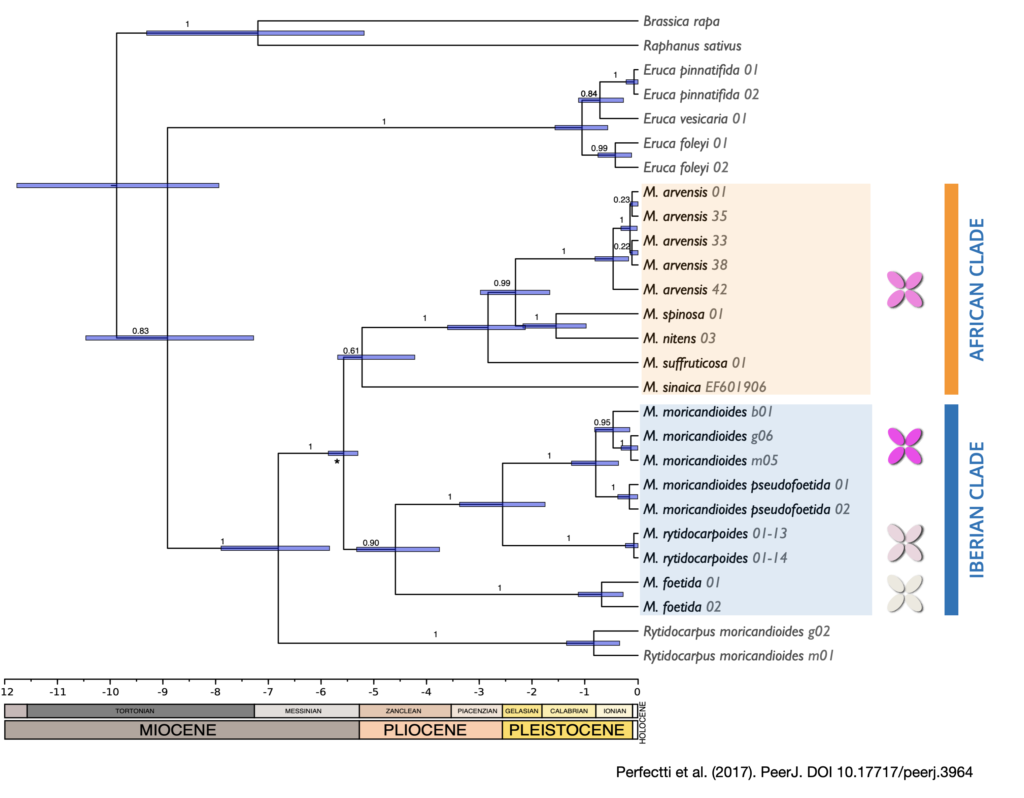In 2017, we presented a molecular phylogeny of the genus Moricandia (Brassicaceae). We found that a Spanish population previously attributed to Rytidocarpus moricandioides is in fact a species of Moricandia, which we named as M. rytidocarpoides sp. nov. Furthermore, M. foleyi appears outside the Moricandia lineage but within the genus Eruca. Thus, M. foleyi has been excluded from the genus Moricandia and ascribed to the genus Eruca as E. foleyi.
The tribe Brassiceae (Brassicaceae) has a complex evolutionary history, which has made its complete phylogenetic resolution difficult. This tribe comprises economically relevant species, including the genus Moricandia DC. This genus is currently distributed in North Africa, the Middle East, Central Asia and southern Europe, where it is associated with arid and semi-arid environments. Although some species of Moricandia have been used in several phylogenetic studies, the phylogeny of this genus was not well established.
In this work, we presented a phylogenetic analysis of the genus Moricandia using a nuclear (the internal transcribed spacers of the ribosomal DNA) and two plastidial regions (parts of the NADH dehydrogenase subunit F gene and the trnT-trnF region). We also included in the analyses members of their sister genus Rytidocarpus and from the close genus Eruca.
The phylogenetic analyses showed a clear and robust phylogeny for this genus. The Bayesian inference tree was concordant with the maximum likelihood and timing trees, with the plastidial and nuclear trees showing only minor discrepancies. The genus Moricandia appears to be formed by two main lineages: the Iberian clade including three species, and the African clade including the four species inhabiting the Southern Mediterranean regions plus M. arvensis.

We dated the main evolutionary events of this genus, showing that the origin of the Iberian clade probably occurred after a range expansion during the Messinian period, between 7.25 and 5.33 Ma. In that period, an extensive African-Iberian floral and faunal interchange occurred due to the existence of land bridges between Africa and Europa in what is, at present-days, the Strait of Gibraltar.

We demonstrated that a Spanish population previously ascribed to Rytidocarpus moricandioides is indeed a Moricandia species, and we proposed to name it as M. rytidocarpoides sp. nov.
Moricandia rytidocarpoides Lorite, Perfectti, Gómez, González-Megías & Abdelaziz sp. nov.
Holotype: Spain: Jaén, Guadiana Menor basin Quesada, close to El Salón, 473 m a.s.l. 37◦48′19.51′′N/3◦09′01.31′′W, marly slopes over bad lands, 04/04/2017, Leg. and Det. J. Lorite. GDA62636.
Eruca foleyi (Batt.) Lorite, Perfectti, Gómez, González-Megías & Abdelaziz comb. nov. (Basionym = Moricandia foleyi Batt. Bull. Soc. Bot. France 61: 52. 1914)
Holotype: Algeria: Sud oranais, Nebkas dans les vallées de l’Oued Namous, et de la Zousfana, Haute Saoura, Bejjig. 04/1913, Leg: H. Foley, MPU006516.
More info:
Perfectti F, Gómez JM, González-Megías A, Abdelaziz M, Lorite J. (2017)
Molecular phylogeny and evolutionary history of Moricandia DC (Brassicaceae)
PeerJ 5:e3964
https://doi.org/10.7717/peerj.3964
